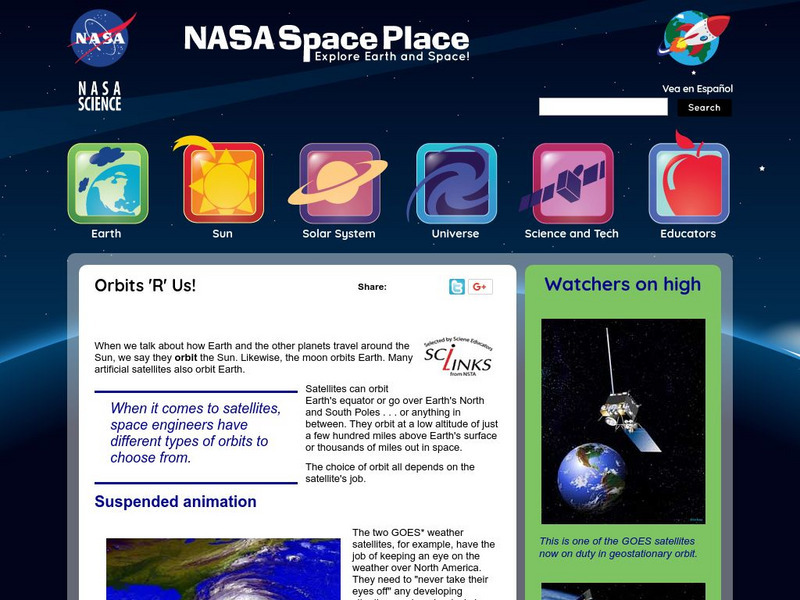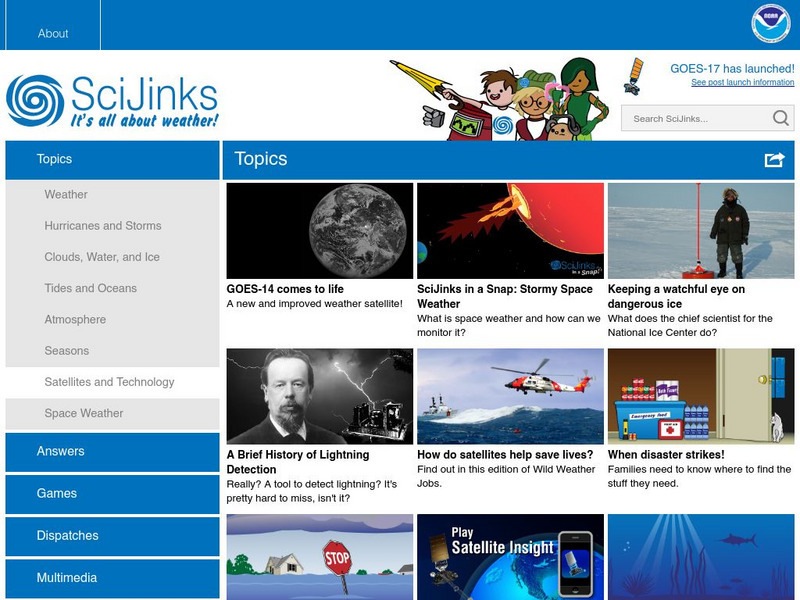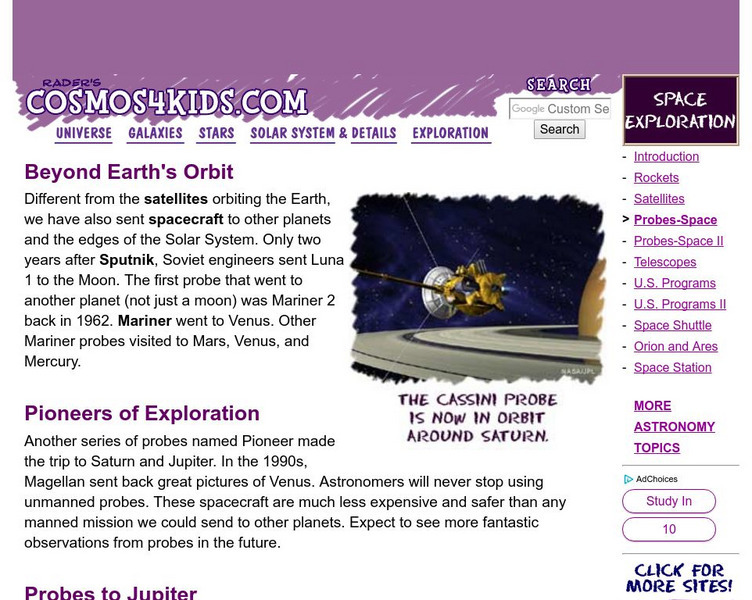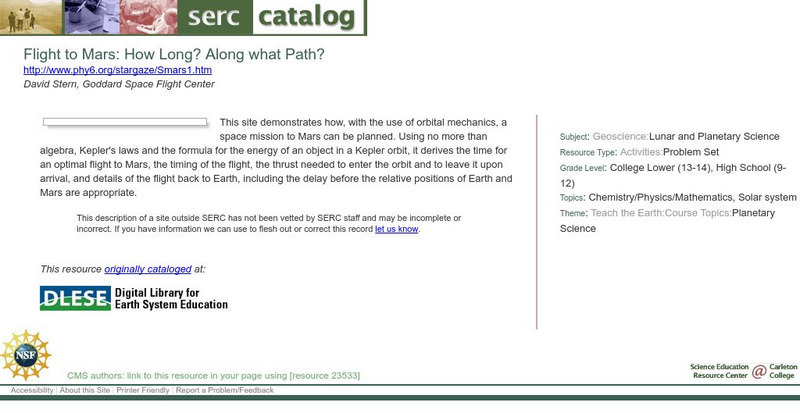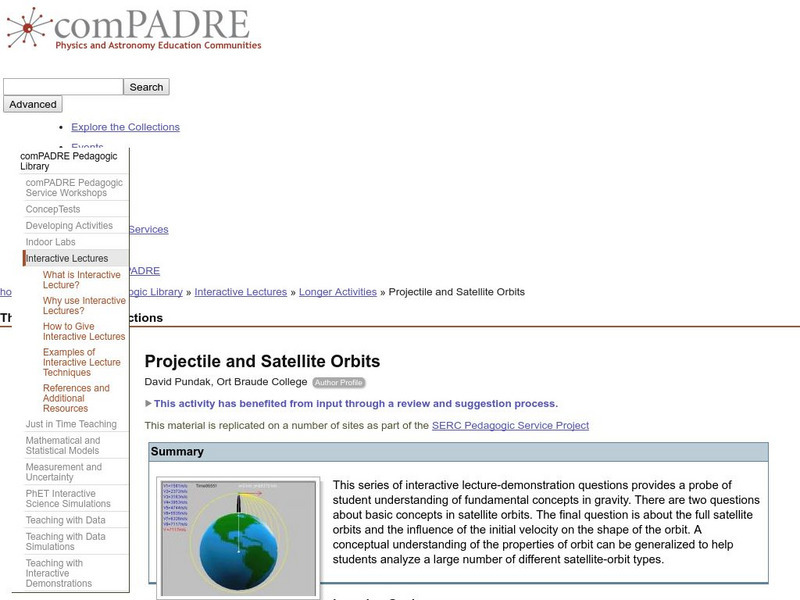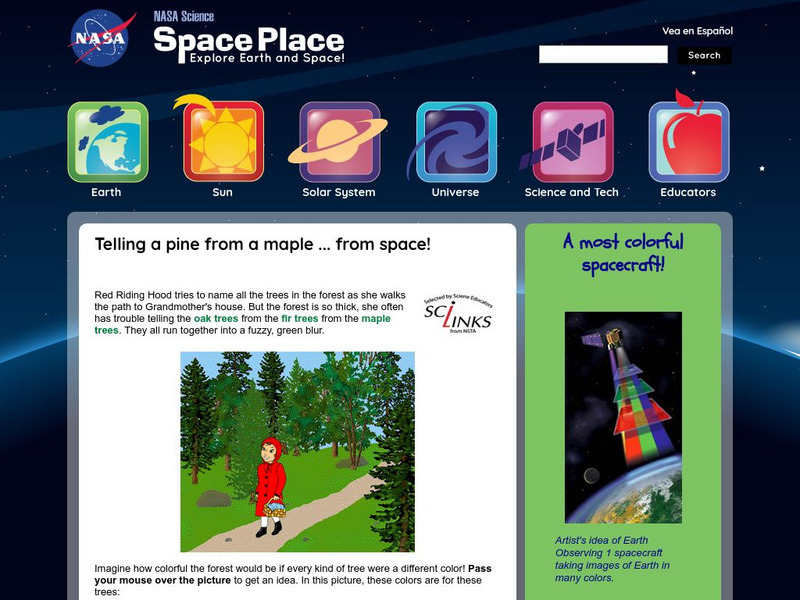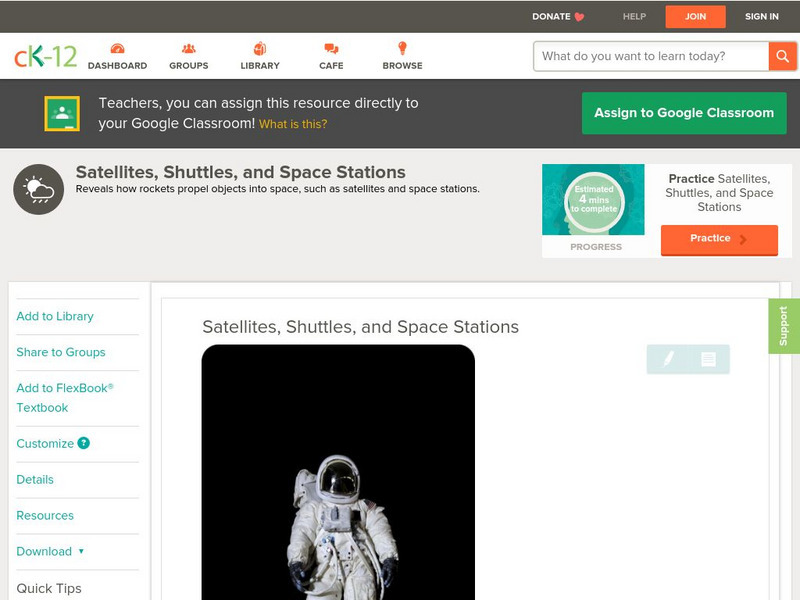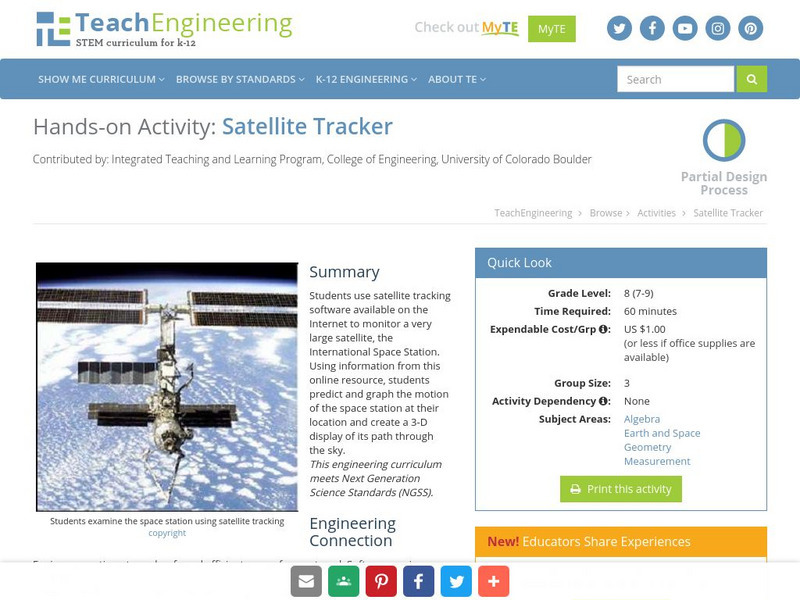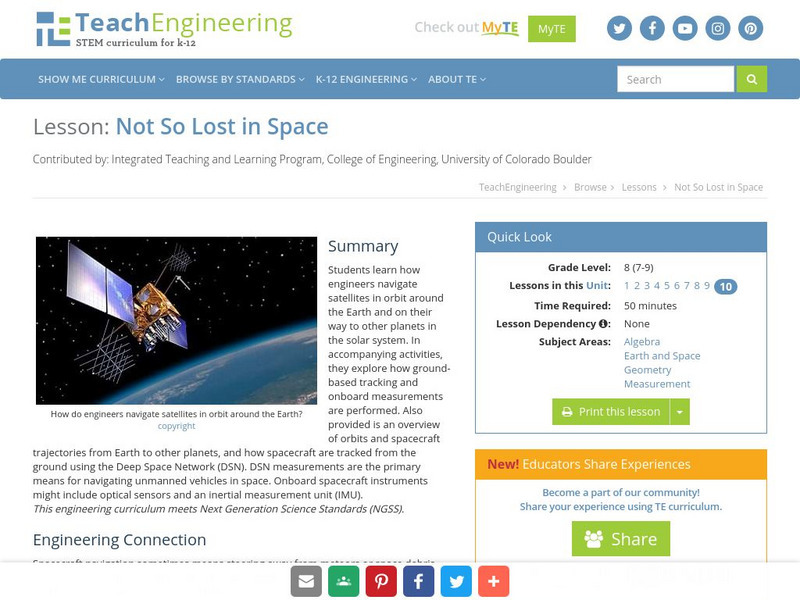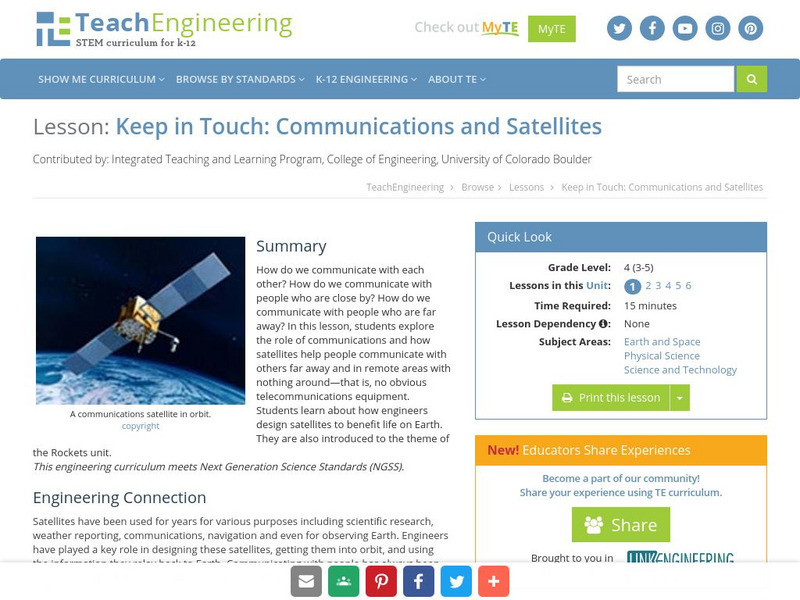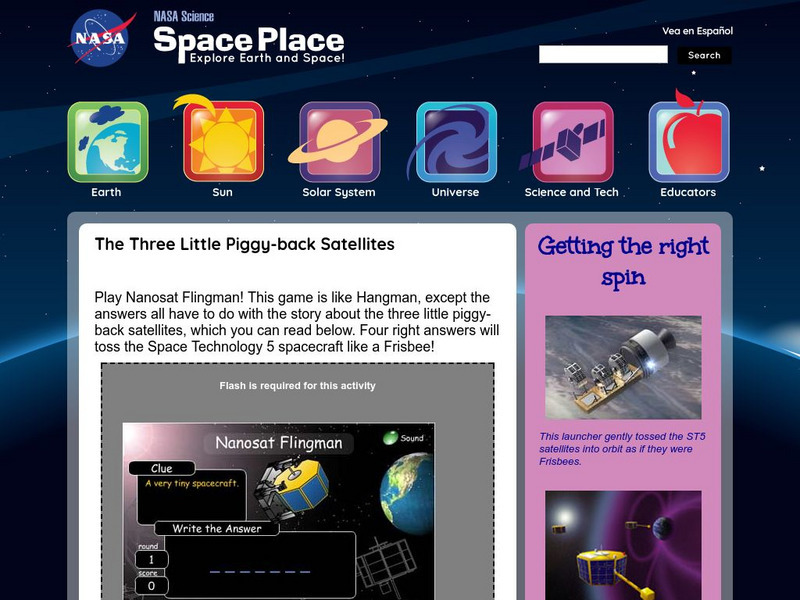CK-12 Foundation
Ck 12 Exploration Series: Simulations: Physics: Clarke's Dream
[Free Registration/Login Required] Learn about geosynchronous orbits and their use in satellite communication.
NASA
Nasa: The Space Place: Orbits 'R' Us
Learn about how Earth orbits the sun and how satellites orbit the Earth. Discover the different types of satellites such as GOES and POES and what they are used to monitor.
NASA
National Aeronautics and Space Administration: Scijinks: Satellites Technology
Describes satellites including what they are used for, important roles they play, how a weather satellite is built, and how a satellite stays in orbit using text and video of varying length.
NASA
Nasa: Slr and Gps (And Plate Tectonics and Earthquakes) [Pdf]
This slideshow explains how satellites are used to measure the movement of tectonic plates.
Concord Consortium
Concord Consortium: Stem Resources: Launching a Satellite
Do you think you could fire an "unpowered" object into orbit? By controlling the angle and speed at which the satellite is launch, students will try to launch a satellite into space with this computer model. Activity includes questions...
Massachusetts Institute of Technology
Mit: Open Course Ware: Orbits of Planets and Satellites
Students explore orbits of planets and satellites. Some topics examined in the activities are planetary motion, angular momentum of orbits, and Kepler's laws. The resource consists of video clips, lecture notes, practice problems, and...
Cosmos 4 kids
Cosmos4 Kids: Exploration: Satellites
Learn about satellites .. early history, manned and unmanned, different kinds of orbits, and more. The brief, to the point text makes this site most suitable for younger researchers.
European Space Agency
European Space Agency: Esa Kids: Our Universe: Satellites
A basic introduction to artificial, or man-made, satellites. Links to information about the planets and other objects in our solar system are included.
Cosmos 4 kids
Cosmos4 Kids: Beyond Earth's Orbit
Learn about the different satellites that are probing the solar system on the website. Also included is a video that explores Astrobiology.
Science Education Resource Center at Carleton College
Serc: Flight to Mars: How Long? Along What Path?
Demonstrate how, with the use of orbital mechanics, a space mission to Mars can be planned. Using no more than algebra, Kepler's laws and the formula for the energy of an object in a Kepler orbit, the exercise derives the time for an...
Science Education Resource Center at Carleton College
Serc: Projectile and Satellite Orbits
This activity introduces gravity and Kepler's Laws and helps to develop an understanding of gravitational force, satellite orbits, and their dependence on the initial velocity.
National High Magnetic Field Laboratory
Magnet Academy: Oersted Satellite, 1999
Named in honor of Danish physicist Hans Christian Oersted, Denmark's first satellite has been observing and mapping the magnetic field of the Earth.
NASA
Nasa: The Space Place: Sorting Out Trees in the Forest
This site from the National Aeronautics and Space Administration provides fun information on the subject. "people can do their jobs even better if they have very accurate images of the ground. Oddly enough, the best way to see lots of...
CK-12 Foundation
Ck 12: Earth Science: Satellites, Shuttles, and Space Stations
[Free Registration/Login may be required to access all resource tools.] Astronauts and space study.
CK-12 Foundation
Ck 12: Earth Science: Satellites, Shuttles, and Space Stations
[Free Registration/Login may be required to access all resource tools.] Astronauts and space study.
TeachEngineering
Teach Engineering: Satellite Tracker
Students use satellite tracking software available on the Internet to monitor a very large satellite, the International Space Station. Using information from this online resource, students predict and graph the motion of the space...
TeachEngineering
Teach Engineering: Not So Lost in Space
Students learn how engineers navigate satellites in orbit around the Earth and on their way to other planets in the solar system. In accompanying activities, they explore how ground-based tracking and onboard measurements are performed....
TeachEngineering
Teach Engineering: Keep in Touch: Communications and Satellites
How do we communicate with each other? How do we communicate with people who are close by? How do we communicate with people who are far away? In this lesson, students will explore the role of communications and how satellites help...
NASA
Nasa: Sci Jinks: Why Do Satellites Have Different Orbits?
Learn about two types of satellite orbits and why the difference is needed.
Read Works
Read Works: Objects in Space
[Free Registration/Login Required] An informational text about some of the objects circling the Earth. A question sheet is available to help students build skills in reading comprehension.
CK-12 Foundation
Ck 12: Plix: Orbital Motion: Distance
[Free Registration/Login Required] The meteor is orbiting one of the 3 planets in a circular orbit. Drag the point associated with each planet to the meteor to see its orbit around that planet.
NASA
Nasa: The Space Place: The Three Little Piggy Back Satellites
This site from the National Aeronautics and Space Administration allows one to read the "Three Little Piggy-back Satellites," and then play the Nanosat Flingman game. [Requires Shockwave]
Physics Classroom
The Physics Classroom: Circular Motion Principles for Satellites
From The Physics Classroom. Uses easy- to-understand language to discuss how circular motion principles apply to the motion of satellites. Describes the tangential velocity and centripetal acceleration of a satellite. Includes many...
Physics Classroom
The Physics Classroom: Mathematics of Satellite Motion
The mathematics associated with the motion of satellites is described. Equations (for period, velocity, acceleration and force) are stated, symbols described, and sample problems solved. Includes five practice problems with solutions and...



